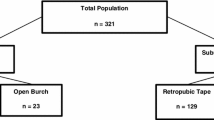Abstract
The suspension of use of sub-urethral mesh in the UK in 2018 has seen the resurgence of colposuspension in female SUI surgery. Open and laparoscopic colposuspension techniques are well recognised. We present data from 28 robotic-assisted laparoscopic colposuspension (RALCp) procedures, reporting on technique, safety and efficacy. Approval was obtained from the hospital New and Novel Procedures Committee. All patients had urodynamic assessment prior to surgery. Data was prospectively gathered and 24-h pad usage and Urinary Incontinence Short Form Questionnaire (ICIQ-UI-SF) scores were used to assess symptom severity and quality of life. PGII scores were used to assess patient satisfaction after the procedure. Paired T test analysis was conducted. Since May 2019, robotic colposuspension has been performed in 28 patients. The mean age and BMI were 49 and 27 (kg/m2), respectively, with a mean follow-up period of 12 months. 67.9% of patients had pure urodynamic SUI and 32.1% of patients had previous anti-SUI surgery. Average operating time was 127 min, blood loss 20 ml and length of stay 2 days. There was a significant 73% improvement in mean 24-h pad usage (p = 0.001) and an improvement in mean ICIQ-UI-SF scores from 18.1 to 9.4 (p = 0.0001). Day 1 mean pain score was 5/10. This is the largest series of its kind. Robotic colposuspension is safe and feasible with significant improvements seen in quality of life scores and number of pads used per day. It presents a minimally invasive treatment option in female SUI, however needs larger volume evaluation and longer follow-up for further evaluation.






Similar content being viewed by others
References
Hunskaar S et al (2003) Epidemiology and natural history of urinary incontinence in women. Urology 62(4 Suppl 1):16–23
Abrams P et al (2003) The standardisation of terminology in lower urinary tract function: report from the standardisation sub-committee of the International Continence Society. Urology 61(1):37–49
Ulmsten U et al (1996) An ambulatory surgical procedure under local anesthesia for treatment of female urinary incontinence. Int Urogynecol J Pelvic Floor Dysfunct 7(2):81–85 (discussion 85-6)
Ward KL, Hilton P, U.a.I.T.T. Group (2008) Tension-free vaginal tape versus colposuspension for primary urodynamic stress incontinence: 5-year follow up. BJOG 115(2):226–233
Novara G et al (2008) Complication rates of tension-free midurethral slings in the treatment of female stress urinary incontinence: a systematic review and meta-analysis of randomized controlled trials comparing tension-free midurethral tapes to other surgical procedures and different devices. Eur Urol 53(2):288–308
Withington J, Hirji S, Sahai A (2014) The changing face of urinary continence surgery in England: a perspective from the Hospital Episode Statistics database. BJU Int 114(2):268–277
BBC (2018) Immediate stop to NHS mesh operations. https://www.bbc.co.uk/news/health-44763673. Accessed June 2020.
Lapitan MCM, Cody JD, Mashayekhi A (2017) Open retropubic colposuspension for urinary incontinence in women. Cochrane Database Syst Rev 7:CD002912
Ward KL et al (2008) Tension-free vaginal tape versus colposuspension for primary urodynamic stress incontinence: 5-year follow up. BJOG 115(2):226–233
Fusco F et al (2017) Updated Systematic review and meta-analysis of the comparative data on colposuspensions, pubovaginal slings, and midurethral tapes in the surgical treatment of female stress urinary incontinence. Eur Urol 72(4):567–591
Singh I, Hemal AK (2009) Role of robot-assisted pelvic surgery. ScientificWorldJournal 9:479–489
Liu CY (1993) Laparoscopic retropubic colposuspension (Burch procedure). A review of 58 cases. J Reprod Med 38(7):526–530
Gumus II, Surgit O, Kaygusuz I (2013) Laparoscopic single-port Burch colposuspension with an extraperitoneal approach and standard instruments for stress urinary incontinence: early results from a series of 15 patients. Minim Invasive Ther Allied Technol 22(2):116–121
Bradshaw AW et al (2020) Robotic Partial Nephrectomy versus Minimally Invasive Radical Nephrectomy for Clinical T2a Renal Mass: A Propensity Score Matched Comparison from the ROSULA (Robotic Surgery for Large Renal Mass) Collaborative Group. BJU Int 126:114–123
Checcucci E et al (2020) Single-port robot-assisted radical prostatectomy: a systematic review and pooled analysis of the preliminary experiences. BJU Int 126:55
Falagario U et al (2020) Robotic-assisted surgery for the treatment of urologic cancers: recent advances. Expert Rev Med Devices 17:579–590
Gallioli A et al (2020) Learning curve in robot-assisted kidney transplantation: results from the European Robotic Urological Society Working Group. Eur Urol 78:239–247
Norton P, Brubaker L (2006) Urinary incontinence in women. Lancet 367(9504):57–67
Khan MS et al (2007) Robotic colposuspension: two case reports. J Endourol 21(9):1077–1079
Francis SL et al (2015) Robotic Burch colposuspension: a surgical case and instructional video. Int Urogynecol J 26(1):147–148
Bora GS et al (2017) Robotic Burch colposuspension-modified technique. J Robot Surg 11(3):381–382
Funding
No conflict of interest.
Author information
Authors and Affiliations
Contributions
NT: urology trainee. data collection, data analysis, manuscript write-up. DS: urology senior clinical fellow, manuscript write-up. DT: clinical teaching fellow, data collection. TN: female urologist, manuscript review. CA: robotic pelvic surgeon, mentoring + training, manuscript review. HQ: robotic pelvic surgeon, mentoring + training, manuscript review. RI: robotic pelvic surgeon, mentoring + training, manuscript review. RW: regional lead for female urology, study design, manuscript review. JS: lead female urology surgeon, concept design, ethical/novel procedure grant, study design, primary surgeon being mentored and trained to deliver the service, manuscript review.
Corresponding author
Ethics declarations
Conflict of interest
No conflict of interest.
Ethical approval
Obtained from novel procedures committee as per Trust guidelines.
Consent to participate
Obtained from participants.
Consent to publish
Obtained from participants.
Additional information
Publisher's Note
Springer Nature remains neutral with regard to jurisdictional claims in published maps and institutional affiliations.
Rights and permissions
About this article
Cite this article
Tan, N., Sri, D., Tsang, D. et al. Robotic-assisted laparoscopic colposuspension for female stress urinary incontinence: a prospective series. J Robotic Surg 17, 125–129 (2023). https://doi.org/10.1007/s11701-022-01409-6
Received:
Accepted:
Published:
Issue Date:
DOI: https://doi.org/10.1007/s11701-022-01409-6



